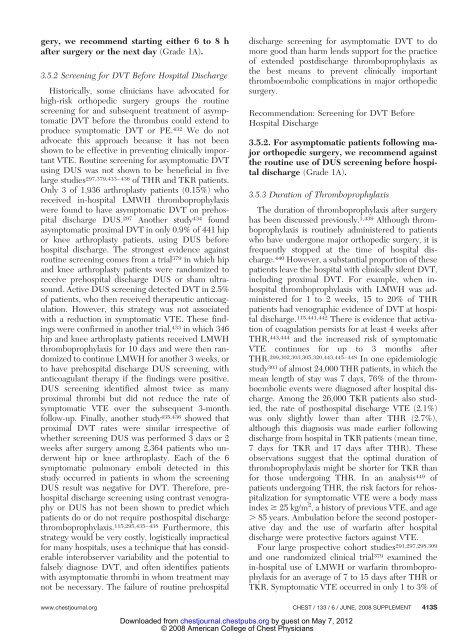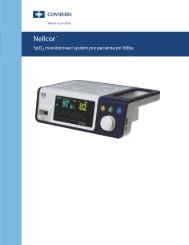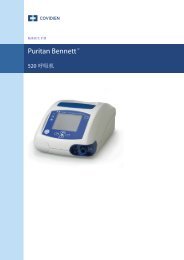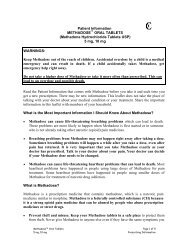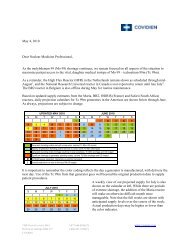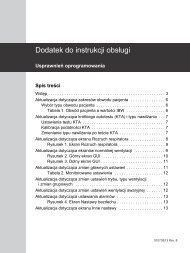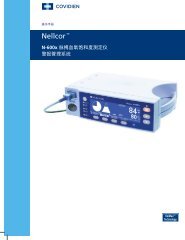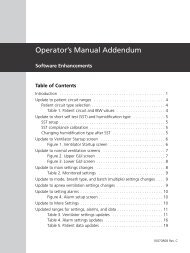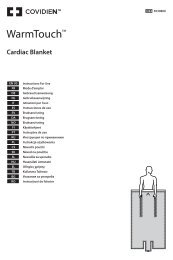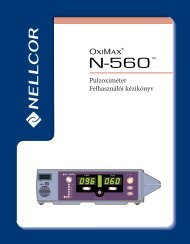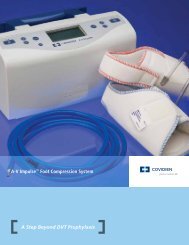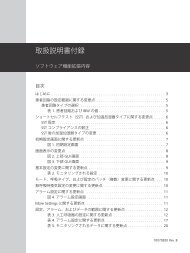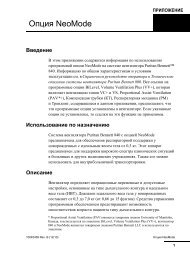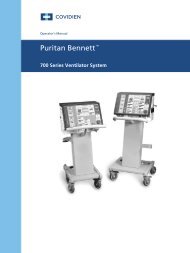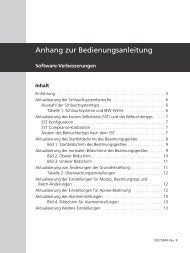Prevention of Venous Thromboembolism - Covidien
Prevention of Venous Thromboembolism - Covidien
Prevention of Venous Thromboembolism - Covidien
You also want an ePaper? Increase the reach of your titles
YUMPU automatically turns print PDFs into web optimized ePapers that Google loves.
gery, we recommend starting either 6 to 8 h<br />
after surgery or the next day (Grade 1A).<br />
3.5.2 Screening for DVT Before Hospital Discharge<br />
Historically, some clinicians have advocated for<br />
high-risk orthopedic surgery groups the routine<br />
screening for and subsequent treatment <strong>of</strong> asymptomatic<br />
DVT before the thrombus could extend to<br />
produce symptomatic DVT or PE. 432 We do not<br />
advocate this approach because it has not been<br />
shown to be effective in preventing clinically important<br />
VTE. Routine screening for asymptomatic DVT<br />
using DUS was not shown to be beneficial in five<br />
large studies 297,379,433–436 <strong>of</strong> THR and TKR patients.<br />
Only 3 <strong>of</strong> 1,936 arthroplasty patients (0.15%) who<br />
received in-hospital LMWH thromboprophylaxis<br />
were found to have asymptomatic DVT on prehospital<br />
discharge DUS. 297 Another study 434 found<br />
asymptomatic proximal DVT in only 0.9% <strong>of</strong> 441 hip<br />
or knee arthroplasty patients, using DUS before<br />
hospital discharge. The strongest evidence against<br />
routine screening comes from a trial 379 in which hip<br />
and knee arthroplasty patients were randomized to<br />
receive prehospital discharge DUS or sham ultrasound.<br />
Active DUS screening detected DVT in 2.5%<br />
<strong>of</strong> patients, who then received therapeutic anticoagulation.<br />
However, this strategy was not associated<br />
with a reduction in symptomatic VTE. These findings<br />
were confirmed in another trial, 433 in which 346<br />
hip and knee arthroplasty patients received LMWH<br />
thromboprophylaxis for 10 days and were then randomized<br />
to continue LMWH for another 3 weeks, or<br />
to have prehospital discharge DUS screening, with<br />
anticoagulant therapy if the findings were positive.<br />
DUS screening identified almost twice as many<br />
proximal thrombi but did not reduce the rate <strong>of</strong><br />
symptomatic VTE over the subsequent 3-month<br />
follow-up. Finally, another study 435,436 showed that<br />
proximal DVT rates were similar irrespective <strong>of</strong><br />
whether screening DUS was performed 3 days or 2<br />
weeks after surgery among 2,364 patients who underwent<br />
hip or knee arthroplasty. Each <strong>of</strong> the 6<br />
symptomatic pulmonary emboli detected in this<br />
study occurred in patients in whom the screening<br />
DUS result was negative for DVT. Therefore, prehospital<br />
discharge screening using contrast venography<br />
or DUS has not been shown to predict which<br />
patients do or do not require posthospital discharge<br />
thromboprophylaxis. 115,295,435–438 Furthermore, this<br />
strategy would be very costly, logistically impractical<br />
for many hospitals, uses a technique that has considerable<br />
interobserver variability and the potential to<br />
falsely diagnose DVT, and <strong>of</strong>ten identifies patients<br />
with asymptomatic thrombi in whom treatment may<br />
not be necessary. The failure <strong>of</strong> routine prehospital<br />
discharge screening for asymptomatic DVT to do<br />
more good than harm lends support for the practice<br />
<strong>of</strong> extended postdischarge thromboprophylaxis as<br />
the best means to prevent clinically important<br />
thromboembolic complications in major orthopedic<br />
surgery.<br />
Recommendation: Screening for DVT Before<br />
Hospital Discharge<br />
3.5.2. For asymptomatic patients following major<br />
orthopedic surgery, we recommend against<br />
the routine use <strong>of</strong> DUS screening before hospital<br />
discharge (Grade 1A).<br />
3.5.3 Duration <strong>of</strong> Thromboprophylaxis<br />
The duration <strong>of</strong> thromboprophylaxis after surgery<br />
has been discussed previously. 1,439 Although thromboprophylaxis<br />
is routinely administered to patients<br />
who have undergone major orthopedic surgery, it is<br />
frequently stopped at the time <strong>of</strong> hospital discharge.<br />
440 However, a substantial proportion <strong>of</strong> these<br />
patients leave the hospital with clinically silent DVT,<br />
including proximal DVT. For example, when inhospital<br />
thromboprophylaxis with LMWH was administered<br />
for 1 to 2 weeks, 15 to 20% <strong>of</strong> THR<br />
patients had venographic evidence <strong>of</strong> DVT at hospital<br />
discharge. 115,441,442 There is evidence that activation<br />
<strong>of</strong> coagulation persists for at least 4 weeks after<br />
THR, 443,444 and the increased risk <strong>of</strong> symptomatic<br />
VTE continues for up to 3 months after<br />
THR. 299,302,303,305,320,443,445–448 In one epidemiologic<br />
study 303 <strong>of</strong> almost 24,000 THR patients, in which the<br />
mean length <strong>of</strong> stay was 7 days, 76% <strong>of</strong> the thromboembolic<br />
events were diagnosed after hospital discharge.<br />
Among the 26,000 TKR patients also studied,<br />
the rate <strong>of</strong> posthospital discharge VTE (2.1%)<br />
was only slightly lower than after THR (2.7%),<br />
although this diagnosis was made earlier following<br />
discharge from hospital in TKR patients (mean time,<br />
7 days for TKR and 17 days after THR). These<br />
observations suggest that the optimal duration <strong>of</strong><br />
thromboprophylaxis might be shorter for TKR than<br />
for those undergoing THR. In an analysis 449 <strong>of</strong><br />
patients undergoing THR, the risk factors for rehospitalization<br />
for symptomatic VTE were a body mass<br />
index � 25 kg/m 2 , a history <strong>of</strong> previous VTE, and age<br />
� 85 years. Ambulation before the second postoperative<br />
day and the use <strong>of</strong> warfarin after hospital<br />
discharge were protective factors against VTE.<br />
Four large prospective cohort studies 291,297,298,309<br />
and one randomized clinical trial 379 examined the<br />
in-hospital use <strong>of</strong> LMWH or warfarin thromboprophylaxis<br />
for an average <strong>of</strong> 7 to 15 days after THR or<br />
TKR. Symptomatic VTE occurred in only 1 to 3% <strong>of</strong><br />
www.chestjournal.org CHEST / 133 /6/JUNE, 2008 SUPPLEMENT 413S<br />
Downloaded from<br />
chestjournal.chestpubs.org by guest on May 7, 2012<br />
© 2008 American College <strong>of</strong> Chest Physicians


